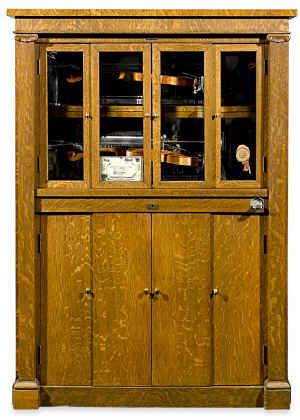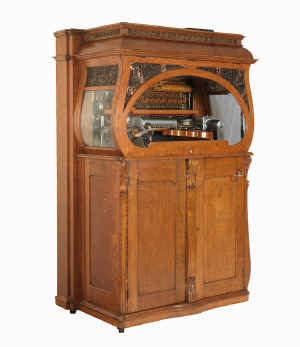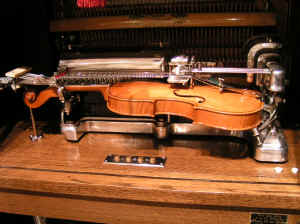|
The Violano Virtuoso
 The
Mills Novelty Company, Incorporated of Chicago, Illinois was once a
leading manufacturer of coin-operated machines, including slot machines,
vending machines, and jukeboxes, in the United States. Between about
1905 and 1930, the company’s products included the Mills Violano-Virtuoso
and its predecessors, celebrated machines that automatically played a
violin and, after about 1909, a piano. The
Mills Novelty Company, Incorporated of Chicago, Illinois was once a
leading manufacturer of coin-operated machines, including slot machines,
vending machines, and jukeboxes, in the United States. Between about
1905 and 1930, the company’s products included the Mills Violano-Virtuoso
and its predecessors, celebrated machines that automatically played a
violin and, after about 1909, a piano.
The main inventor of the Mills Violano-Virtuoso was
Henry Konrad Sandell who was born in about 1878, & therefore a
contemporary of Thomas Edison.
Henry Sandell arrived in the United States from
Sweden at the age of 12 in about 1888. He was granted his first United
States patent on the mechanism at the age of 21, in about 1899 and put
his proposals and patents before the Mills Novelty Company in about
1903.
On 27 March 1905 Henry Sandell filed an application
for a United States patent for an electric self-playing violin. The
patent was granted on December 19, 1905 and assigned to Mills Novelty
Company. This forerunner of the Violano-Virtuoso was known as the
Automatic Virtuosa. It was marketed in 1905. At the time player pianos
and mechanical coin-operated devices were extremely popular. These very
early instruments did not have pianos. It quickly became evident that a
piano needed to be added to make the machine more popular and more
pleasant to listen to. Most were returned to the factory and retro
fitted with a piano back.
The United States Patent and Trademark Office had a
display of several significant inventions at the Alaska-Yukon-Pacific
Exposition in Seattle, Washington in 1909, including an early Violano-Virtuoso.
The company used this event to promote the Violano-Virtuoso as
"Designated by the U.S. Government as one of the eight greatest
inventions of the decade" on all subsequent machines.
The Violano-Virtuoso was not available to the public
until 1911. Technology used in the instrument was patented on June 4,
1912. Early Violano-Virtuoso’s have a glass divider between the violin
mechanism and the piano mechanism. Machines with two violins are known
as the De Luxe Model Violano-Virtuoso or the Double Mills.
In 1914 an instrument with many very early rolls was
presented from the Mills Company to the Smithsonian Institution. It
still exists today and is located in the Smithsonian Directors Office.
 The
exact number of machines produced is not known. Estimates are between
4,000 and 5,000. Today, some sources estimate that only about 750 of the
single machines and fewer than 100 of the Double Mills still exist,
while other sources estimate that several thousand machines survive.
However, the Violano-Virtuoso have the highest survival rate of any type
of player piano; they required little maintenance when they were first
produced and that is still the case for those that survive. The
exact number of machines produced is not known. Estimates are between
4,000 and 5,000. Today, some sources estimate that only about 750 of the
single machines and fewer than 100 of the Double Mills still exist,
while other sources estimate that several thousand machines survive.
However, the Violano-Virtuoso have the highest survival rate of any type
of player piano; they required little maintenance when they were first
produced and that is still the case for those that survive.
A common player piano operates pneumatically, moved
or worked by air pressure. The Violano-Virtuoso was all electric and all
the moving parts were set in motion by electric motors or
electromagnets. A company catalogue states that they ran on "any
electric lighting current" and used "no more than one
16-candle power light." They were designed to operate on 110 volts
direct current. In locations that had 110 volts alternating current, or
other types of power supply, the instruments were used with a unique
converter unit.
The violin had four strings, with an octave available
on each string, and could reproduce 64 notes. All four strings could be
played simultaneously. This allowed the possibility of four-part
independent counterpoint. A vibrato could be produced.
The piano had 44 notes, half the number of keys found on a normal
piano keyboard. The piano was played by regular hammers using a standard
player piano action. The hammers were activated by electromagnets. The
piano frame was made of iron, shaped like a shield, and symmetrically
strung. The bass strings were at the center of the frame and the treble
strings branched out to the edges from the center. This arrangement
distributed the string pressure more evenly across the frame and helped
keep the piano in tune.
 The
Violano-Virtuoso was coin-operated and its mechanism was capable of
holding up to 15 coins. Some models were made for domestic use and did
not have the coin mechanism. The
Violano-Virtuoso was coin-operated and its mechanism was capable of
holding up to 15 coins. Some models were made for domestic use and did
not have the coin mechanism.
The instrument used rolls of perforated paper. Most
of the rolls had five tunes on them, the popular tunes of the day.
Individual tunes could not be selected. Over time, the Mills Novelty
Company produced approximately 3,121 different rolls. Each arrangement
of a song was identified by a unique number. Some songs appear on more
than one roll.
The Violano-Virtuoso was a very heavy object. The
first page of the Violano-Virtuoso manual stated that to lift the
instrument from the delivery wagon would need "3 good men".
Production of the Violano-Virtuoso seems to have
finished in 1930. Henry Sandell died in 1948, at the age of 70.
The Violano-Virtuoso was designed for public places,
and can be considered to be a beautiful work of craftsmanship.
In addition to the Violano-Virtuoso, the Mills Novelty Company
developed a variety of other automatic musical instruments. These
included the Viol-Cello, the Viol-Xylophone, and the Mills String
Quartette.
|